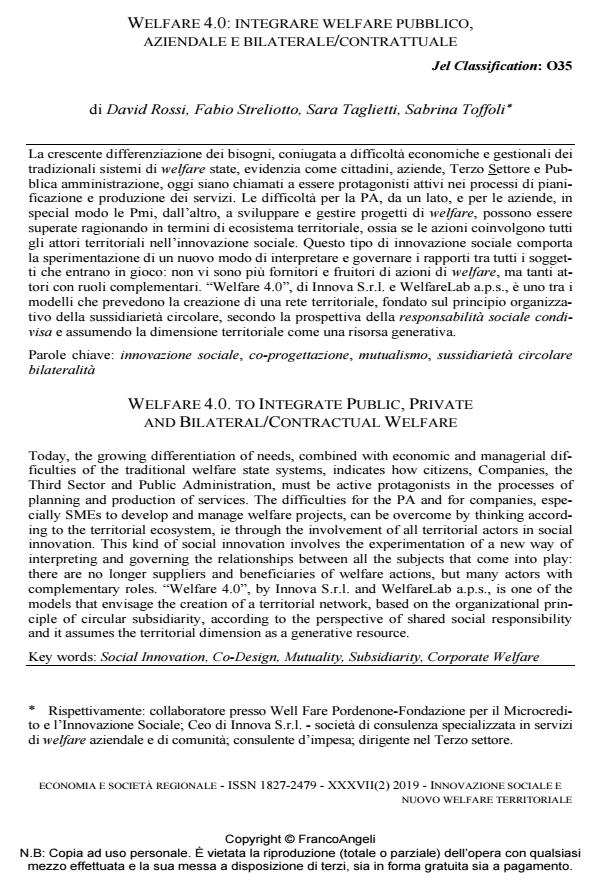Welfare 4.0. to integrate public, private and bilateral/contractual welfare
Journal title ECONOMIA E SOCIETÀ REGIONALE
Author/s David Rossi, Fabio Streliotto, Sara Taglietti, Sabrina Toffoli
Publishing Year 2019 Issue 2019/2 Language Italian
Pages 14 P. 58-71 File size 316 KB
DOI 10.3280/ES2019-002006
DOI is like a bar code for intellectual property: to have more infomation
click here
Below, you can see the article first page
If you want to buy this article in PDF format, you can do it, following the instructions to buy download credits

FrancoAngeli is member of Publishers International Linking Association, Inc (PILA), a not-for-profit association which run the CrossRef service enabling links to and from online scholarly content.
Today, the growing differentiation of needs, combined with economic and managerial difficulties of the traditional welfare state systems, indicates how citizens, Companies, the Third Sector and Public Administration, must be active protagonists in the processes of planning and production of services. The difficulties for the PA and for companies, especially SMEs to develop and manage welfare projects, can be overcome by thinking according to the territorial ecosystem, ie through the involvement of all territorial actors in social innovation. This kind of social innovation involves the experimentation of a new way of interpreting and governing the relationships between all the subjects that come into play: there are no longer suppliers and beneficiaries of welfare actions, but many actors with complementary roles. "Welfare 4.0", by Innova S.r.l. and WelfareLab a.p.s., is one of the models that envisage the creation of a territorial network, based on the organizational principle of circular subsidiarity, according to the perspective of shared social responsibility and it assumes the territorial dimension as a generative resource.
Keywords: Social Innovation, Co-Design, Mutuality, Subsidiarity, Corporate Welfare
- Becchetti L. (2017). Uno strumento per votare col portafoglio. La felicità sostenibile - Blog. la Repubblica del 20 luglio -- <http://felicita-sostenibile.blogautore.repubblica.it/2017/07/20/uno-strumento-per-votare-col-portafoglio/?refresh_ce>.
- Benvegnù-Pasini G., Vecchiato T. (2014). Il welfare generativo e le sue potenzialità. Studi Zancan. Politiche e servizi alle persone, 6(6): 5-12.
- Cesareo V., a cura di (2017). Welfare responsabile. Vita e Pensiero.
- Cgil - Cisl - Uil e Forum del Terzo Settore (2004). Documento di intesa in materia di politiche sociali. 26 aprile. Milano.
- Fornasier S., Lucchini G., Streliotto F., Vecchiato G. (2019). Welfare 4.0: Competere responsabilmente. Milano: FrancoAngeli.
- Orlandini M., Rago S., Venturi P. (2014). Co-produzione. Ridisegnare i servizi di welfare. Short Paper 1. aiccon cooperazione non profit. -- <https://www.aiccon.it/pubblicazione/co-produzione-ridisegnare-servizi-welfare/>.
- Sen A.K. (1985). Commodities and Capabilities. Amsterdam - New York: Elsevier Science Pub. Co.
- Venturi P. (2018). Tracciare l’identità e la fiducia. Milano: Nòva Il Sole 24 Ore.
- Zamagni S. (2013). Impresa responsabile e mercato civile. Bologna: il Mulino.
- Zamagni S., Venturi P. (2017). Da Spazi a Luoghi. Short Paper 13. aiccon cooperazione non profit -- <https://www.aiccon.it/wp-content/uploads/2017/06/short-paper-13-1.pdf>.
- Porter M.E., Kramer M.R. (2011). Creare valore condiviso. Come reinventare il capitalismo e scatenare un’ondata di innovazione e di crescita. Harvard Business Review Italia, 1/2: 68-84.
David Rossi, Fabio Streliotto, Sara Taglietti, Sabrina Toffoli, Welfare 4.0: integrare welfare pubblico, aziendale e bilaterale/contrattuale in "ECONOMIA E SOCIETÀ REGIONALE " 2/2019, pp 58-71, DOI: 10.3280/ES2019-002006